Chapter 6. Telescopes in Space
6.1 Introduction

Author: Scott Miller, Pennsylvania State University
Editor: Beth Hufnagel, Anne Arundel Community College
The goals of this module: After completing this exercise, you should be able to:
- Explain why astronomers put some telescopes in space.
- Recognize which wavelength ranges of light are best to observe different objects.
- List, by wavelength regime, how well each type of light can reach the surface of the Earth.
- Explain why astronomers need to take a multi-wavelength approach to observations.
In this module you will explore:
- How Earth's atmosphere lets some light through but blocks other light.
- Various space telescopes and their primary missions.
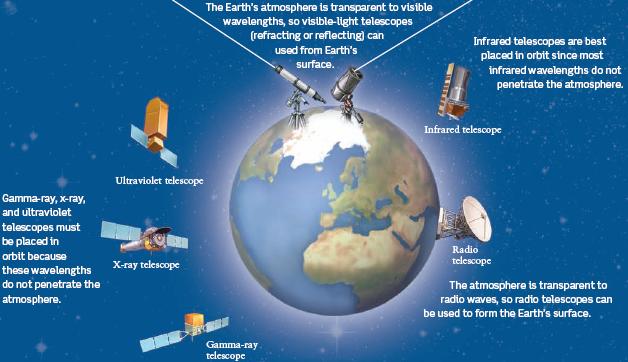
Why you are doing it: Different objects in space give off different types of radiation including light, neutrinos, cosmic rays, and gravity waves. Indeed, most objects give off multiple types of radiation! Little of that radiation actually makes it all the way down to Earth's surface, so if we want to learn more about the universe and everything in it, we need to be able to observe all the different types of radiation out there.
6.2 Background

While telescopes have been around since Galileo's time, for hundreds of years we only had telescopes that could observe visible light. ('Visible' light is also called 'optical' light.) The Earth's atmosphere is transparent to visible light; visible light can pass through it to the ground. So ground-based visible telescopes were useful to study outer space. Earth's atmosphere is opaque to most other wavelengths (either partially or fully), though; they cannot fully penetrate Earth's atmosphere, and so we cannot see these forms of light from the ground if they originate in space.
Over the years, astronomers began to theorize that objects in space must give off light at a variety of wavelengths. Indeed, by only observing in visible light, they were missing most of what's out there!

Over the years, astronomers began to theorize that objects in space must give off light at a variety of wavelengths. Indeed, by only observing in visible light, they were missing most of what's out there!
Question 6.1
oH068ZxdYhkNaJy0gqVVHGUombFLTM1TwMNPVjhEqkFgV1G7axFMG+TEABf/oCeI0LLz8O8a7VlxTQM4MTb4Dlus6OmSxJBdbo4XAbvRKQ8IzvFdiCbpvkrgXDdp46R+wcYVD0Gw2wQ2HiEMqSA5trdoVsEQI1YL2pBK0UN8RcF3raFVVX3lZOVaTbuXD+rfgQc0DVYrViRDOCjL/4FBD7oRF37bQPbZo1ThpHkN+xYshTtByAAGuT7ouTju3PgYlrrHsT6TU2DXGlrimg8iWjRxdmE59aDMKevvYRGcPB+5+y3sY2GEsX5jYMMW7OHfDPSz6L6IxXnS6YXNe9SwAoMr7D1e97hISXEhWL6lMq/9Gz6x4SbRVuNTyCUgoqkf+tvj/HlCdkOjjbCtkCiGTiwtUCxqfi5twZEVQCLIufwyXTWt6.3 Temperature Determines the Wavelengths of Light Emitted
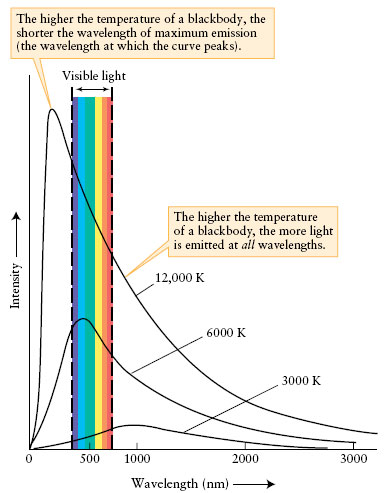
Astronomical objects give off light at wavelengths that depend on their temperature. Dense objects such as planets, stars, and some galaxies (and human bodies, too!), have spectra that are continuous, or spread smoothly over many wavelengths.
These are called blackbody spectra, and the amount of energy emitted per area per second (energy flux) and the maximum wavelength can be calculated. Just as you would think, when the temperature of the object increases, the amount of energy emitted increases and the peak wavelength decreases.
The related formulas to do these calculations (Stefan-Boltzmann law and Wien's law) are beyond the scope of this activity, but we encourage you to learn about them in "The Nature of Light" activity.
Question 6.2
vHqNmbFvPO8VYKPvC8dQNHVVDSDGiDKAocGfe/9iWiQkP76snbXpVL7RqETCWP73/ex4OHSQxqkYM/RTuPY1emSUfTGP+9GBXtldYKdr6KZHPIFL2sxnXgTuyi+a4LOVLRx+f3Fz7dpqHygsougmUxA6t6mWeolYaIQVWMGlJyBl93vg15+rcq3Y400UjPDfsv31HEcVQbe4KEQxcI4LJOGo8iOn2GgI2t/zVLSjokLJ3Q/8vWssIC+StC2seBCdCyjql5irAa4aXCi+AahnqrrtDSDTB48CgXiaiYhvc1HwczqH3dw9dH3lnVR2ynF6V23UMqBgMxKbUGj0/H3gOTqa7k5i/ePDQKaGLW90X6+WnUFAeiXVBwKU042x4dPMQ03qDKLzbTXBmFrlT07sfeBEoFvjV3AwETS5cf5NcD3gJ8UczaEvR5VAA76Z2MPgycRN0pWMo5HCBUB76.4 Specific Astronomical Objects
Below is a list of important astronomical objects or phenomena that are best observed at particular wavelengths. The wavelength regimes are presented in order of longest wavelength/lowest energy (radio) to shortest wavelength/highest energy (gamma rays):
Click on the names in the right column to view images.
| Radio | [Magnetic Fields]{asset/magnetic.jpg} |
|---|---|
| [Interstellar Gas Clouds]{asset/gasclouds.png} | |
| [Galactic Structure]{asset/galacticstruct.png} | |
| [Radio Galaxies]{asset/radiogal.png} | |
| [Cosmic Background Radiation]{asset/cosmicback.png} | |
| Infrared | [Star Formation]{asset/starform.png} |
| [Galactic Nuclei]{asset/galnuc.png} | |
| [Active Galaxies]{asset/activegal.png} | |
| [Large-Scale Structure Of The Universe]{asset/unistruct.png} | |
| [Extra-Solar Planets]{asset/extraplanet.png} | |
| Visible | [Planets]{asset/planet.png} |
| [Stars]{asset/stars.png} | |
| [Galaxies]{asset/galaxies.png} | |
| [Nebulae]{asset/nebulae.png} | |
| Ultraviolet | [Hot Stars]{asset/hotstar.png} |
| [Chemical Element Abundances]{asset/chemel.png} | |
| [Interstellar Gas]{asset/intergas.png} | |
| X-Ray | [Supernova Remnants]{asset/supernovarem.png} |
| [Accretion Disks]{asset/accretion.png} | |
| [Hot, Ionized Gas Around Galaxy Clusters]{asset/iongas.png} | |
| Gamma-Ray | [Pulsars]{asset/pulsars.png} |
| [Novae]{asset/novae.png} | |
| [Supernova Explosions]{asset/supernova.jpg} | |
| [Gamma-Ray Bursts]{asset/gammaburst.png} |
Question 6.3
GOciCTdBn49BD3fLRyCzealoJwfudRihXImmvPWZqqfjr+PlxoPqKu08XTzRBx/YKf+3YL+l4wJhvpDNQObUPnVUvN5sq7SyvXZ+Mh2nGxTylDl+mRiU4PsG3aiDKeUWZ9qrJ2cEOamuMoW0j2FT66TX6z25kw1S9v0u32JwcLty5+EngiuqHL+Ta+VUQ6BCvv+UOvu4gEEtHVkHvbubQG8+8pTr969Gw6rGFJ1vb2JAC2z7Pgz5qvuyhN7wdNPQLtjgANojIccCiWBxeoP5czqCuQy+WOIEV8EsQGVu6qMy2WZabHYBIRjkKzWEojffVJyOC5zQXQfjRDmDGV5iD08reppbbQLwcYJQkh92mh0m6sQrJqixnCNeTPMQ0wummBMOQqUL9JHXzu3Et6bvMT+pGP/EwxQSR3JHACNKXra1BOZsbYolQYpbFb2EN3q0SGDy2dnOJnBUUtI/UK/7xT/VYS68brG+nifcluhWCDaSgGg8xPxqq/zmc+osO2d44ukuEjFC2ktDYVUhYSId7c6X19lSS5Iq3P18yiEAEDR1MowSLK+UvL3sPLZNHWU75yBK+Nw/JwotjtvQF9jB3oJEXAR/rG2rOk/F0sE6SIJScnGfVN8F4KDx65ZgfMemLAQaaWycuu3ML96odTp9YiCWKwgZjDsFt2J3syH527mTeKVKOgD+q1JpuRGSHYG0akupJ7BljTnvlHUTi/OufiNnG751Xp3DnzxNeV6Ij5grwNK5mGZvUXoWm4EKSG5ilzOqLkA7ImJvBizcaib2fotxjYX7hZXme/13pqyjAkthvrk6cKXo95KyhS4wI3m7PrdiVZSed2SLzxGm/v/ot2HQX4u57LyHmESApc0mkVYr95leR8IRjimSN7JIJAUK1kaoGiXNTXIiV/m92T+L7mxvueqZiLYtN2U3hW4tnr9IWxjEfQBWTnhAdlJVqoBZhJ6eOC4BsDUl3/NTQ9Fjx3Qq7B7G2TcRo9VutB4pXHtfzIQXDqqk16mwyAqDCN24q/ZfQc+P8AjwMFE31x9s5LMAiAdj2yjLpahjlmSjXU0t3HSmeFVVeWkaGFc0WJmmTWjStuaZjWWBAEDphngbDjS/Vh/Be1eL25jwPptRPt8uRLBHR9YpX2+ez3PNiJlOXnL7zA==6.5 Atmosphere's Penetrability To Different Kinds Of Radiation
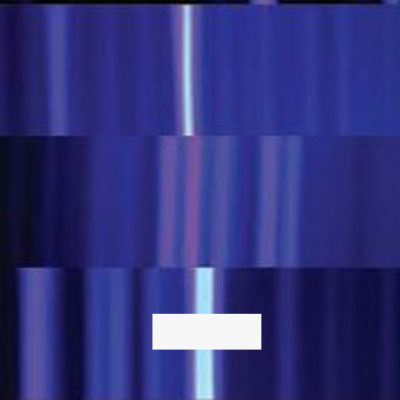
The animation above shows the Earth surrounded by an atmosphere. On the top are a number of different types of light. Click on the various wavelengths to see which ones can pass through the Earth's atmosphere, which can pass sometimes, and which ones can't pass through at all. Earth's atmosphere is partially transparent to some types of light, blocking some but not all of it from reaching the ground. These small bursts of light can be described as particles called photons.
Question 6.4
epWyNc6oQvn8b8hBJGTuboEr7oguc9jmGJnHCJ23voBgiGvIVS93DCOkajI/PwqMdOw/r23HFTFwS7npJIw01YHekTtbjH+llvk31AmGz+F+GvO8+yxd5f7GC10urwZ+l7+xqlG4RVqXOg7M5XbRmRBGV7ZLSfT9voUrpeqtlGqoFNWE6OBtK5emb6L9ZZeVvfJvf4W0b6eBDV/WfQ++bpRI9MvnQ4sFZqDXFr6XCzGaChYPkwt8SrObp07Ka5xSTmjiWvco8aSloBnQ3CGG+K09St+0n92RLRYhZJ7+5kOH67CXgPMYqpt2IVFTnyX96.6 The Murky Infrared "Window"
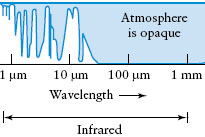
The main absorber of infrared radiation is water vapor. Therefore, astronomers would like to build infrared telescopes in places where there is little to no water vapor.
Question 6.5
VO6UBwlAzY9pACzw8jinlAgHErat3PkMLXR5RQkmqU/H65XkvYUwrayNcTajF61Y8P+6kg1ethC21XldGNoxM7Fa9bmAB7eXl8r7ov9Nn/q84a3fB9yY2dM0kg06QBwpmv8ORwQsWnIvOV41UGwxP3K7jtbnMWW9+qlEjfUImZ2uf24a0nfGrIFASfqOMOr1Vz0U8KKluFyZVkMYjtYiRIZ0zZ92bKRGn1svKFOf+FDqxZfpFuDdu++oO9Z0hSq3Es1RXcznEnNEdRotWAjPrjsX1Mt1ac4hIFk63og6f5knVTvZLAiZJFnFWlvfkjFIa5Of8B4kSAhuQVpdy3ktMA==6.7 The Spitzer Space Telescope

In 2003, astronomers launched the Spitzer Space Telescope into outer space. The 85-cm Spitzer Space Telescope is designed to observe radiation in the infrared range, specifically the wavelengths that cannot pass through the Earth's atmosphere. This is why a space telescope observing between 3 micrometers or microns (μm) and 180 μm is so important. Due to its ability to detect longer-than-visual wavelengths, the Spitzer Space Telescope is able to make observations through gas and dust which can block visible light, allowing us to detect hidden regions of star formation, galactic nuclei and galaxies which formed shortly after the Big Bang. One area of great interest in infrared astronomy is the detection of extra-solar planets. Stars greatly outshine planets in visible light, making it hard to detect planets around other stars in visible light. These same planets, though, emit light in the infrared portion of the spectrum. At the same time, their parent stars are dimmer in the infrared than they are in visible light, making it easier to detect planets at these wavelengths.
6.8 The Ultraviolet Window

Ultraviolet radiation is another wavelength range that can partially pass through the Earth's atmosphere. (This is why you should look for "UV-blocking" when buying sunglasses and sunscreen.) In the case of ultraviolet radiation, it is ozone that prevents it from fully penetrating our atmosphere. Ozone consists of three oxygen atoms bonded together (this is different from the oxygen we breathe, which consists of two oxygen atoms bonded together).
Question 6.6
+OeAljSZxX/pGcqferH+pYJWjdflSFa8JyZe1imaXt2fJhNMbbiB+zQ+vZP/qQ2DSk7iUM4eEDwW7hhG1R8MI+chii1DihAv73O0CgYa4mZKlp6GVmpbmk6TtNLhaeamnMUoHS1UMD3eHEff9Fatb3nzaKgmFMYmZKqAYg+YD2UNpRsQNGw3QQ2jFqvm0j1EePVpg2/r27BdnlE1k5SqxEq/xkyGVUTH7d2KDKhJIm4MKNB/SBzlvExmMg3Dz0IlH2kIvtD3J/NopJYnGFlWaTymtHtV9uO/oe0zkKZvIX/09pz30wc1EqRYtSKcNnLTzhX+vzPOPkD0tpwvAnCHfDV/N284EDLKtP+GFM/ZIeZEjeJloxMC1PMN6rFXZXhd5OlU1fJeXpdDfpiU1E4jhN/QbrMY1BQ26.9 The Far Ultraviolet Spectroscopic Explorer
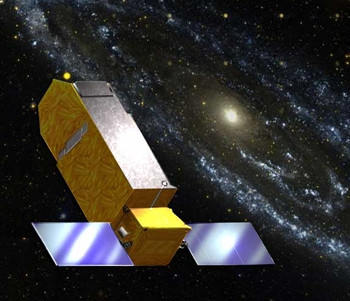
As ultraviolet sunlight enters Earth's atmosphere, the ozone in it absorbs this radiation, being destroyed in the process. Other natural processes replenish this ozone so that Earth continues to have a stable ozone layer. (CFC's are artificial chemicals that drift up from the surface where humans release them and also destroy ozone, but much more effectively than ultraviolet light.) While an ozone layer is good in the respect that it protects us from harmful ultraviolet rays (which could cause skin cancer or worse), it also means that astronomers need to put ultraviolet telescopes in space in order to observe in this wavelength range.
In 1999 NASA launched the Far Ultraviolet Spectroscopic Explorer (FUSE) into orbit in order to obtain high-resolution spectroscopic images in the far-ultraviolet range (roughly 90 to 120 nm). FUSE was designed to study such astronomical objects as deuterium in the interstellar medium, which will give insight into the state of the universe only minutes after the Big Bang, and clouds of interstellar gas, from which new stars and planets form and also help us to understand the evolution of galaxies over time.
6.10 The X-Ray 'Wall'
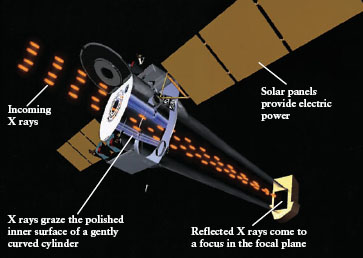
Since the Earth's atmosphere is completely opaque to X-rays, if we want to observe in this wavelength range at all we must build X-ray satellite telescopes. However, astronomers were confronted with the problem of how to focus the incoming X-rays.
Question Sequence
Question 6.7
D0+bPwv4oXLtJ0KqUdzbpx187F2vB0Aev4ujbmlqA4FqggKQ8/8aT1/ysnjdZwknpaNi5njQJUMlliiyCS3Mk4jNNIp5nBb9DYtw9M5jgMmsgPwtzCMMcSoYJIUcgxKhgEk57j6QImrdCe3IDUgz7xtPSKFVTNiOIUdgwOcFstwoZiuYMfA/KHGghT34a2kgEkexcJZHX6ydPPREBtxOVLoFFYJHsqzR3zMMuR+zF+jM+f31MH/ByUPOkqO6vjR+Zy7TvKpPEjihn1QZKMDaWCdKgaFWb/6p3MGGU3VmzNkw7HFqakWRng==Question 6.8
kCLVf+eV0DGzgyem6SlEJJhl2olN0GGzwmvxTujv0aM+bKjnr9EflKLWF+Co+XJlrIUY7Ku6d3tpz1CpXzk4qVUqdHVVaiYs56l5WBYVJP3nWwvkpIECBrgqAEBRgiCYpTVNyL3oI/BAeNmGVqd8/xOCrIF4KPDxhs1GhS/hqQEFRrFKiwROqKL7Fk4=Summary
In 1999, NASA also launched the Chandra X-ray Observatory into space. Chandra is designed to detect X-rays from high-energy or extremely hot regions of space with temperatures on the order of millions of Kelvins (K). (The temperature of the surface of the Sun is 'only' 5800 K.) Some prominent observations so far have been the detection of; the violently expelled outer layers of massive stars as they die (supernova remnants), accretion disks of material surrounding black holes, and huge complexes of hot, ionized gas surrounding hundreds of galaxies and gravitationally bound to them by dark matter.
Around the same time, the X-ray Multi-Mirror Mission (XMM-Newton) Telescope was also launched into orbit. While it is not able to achieve the same level of resolution as Chandra, the XMM-Newton Telescope is composed of three X-ray telescopes, which combined can gather light five times faster than Chandra, allowing observers to detect fainter objects. In addition, the XMM-Newton Telescope also contains an ultraviolet/visible telescope, which can simultaneously observe objects, providing multi-wavelength observations of a variety of objects.
6.11 Why Observe an Object in Many Wavelengths?
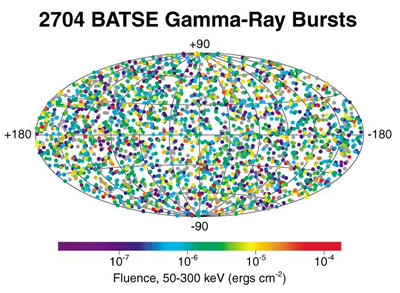
Gamma-ray detection must also take place high above the Earth's atmosphere, since none of this high-energy, short wavelength light can penetrate it. Gamma rays are the highest energy photons, and extremely hard to focus. In fact, it is very difficult to image a gamma-ray source. Since it is so hard to determine from which direction the photon came, astronomers can only estimate the location of the source of the gamma rays making it important to observe these regions at other wavelengths.
In 1991 NASA launched the Compton Gamma Ray Observatory (CGRO) to observe gamma rays from 30 kilo-electron-volts (keV) to 30 billion-electron-volts (GeV) in energy. During its nine-year mission, CGRO observed a variety of phenomena, including solar flares, pulsars, nova and supernova explosions, black holes and quasars. The most exciting and intriguing observations, though, would have to be of gamma-ray bursts.
This figure demonstrates the locations of gamma-ray bursts detected by CGRO over a period of time. This is a 360-degree view, as if you pointed a video camera and then turned around with it running until you get back to where you were originally looking.
Question 6.9
w0JAxif5no+7dTDKnQWM6SnGUDVv18tjv0Dktd1PZGlBp5RZumRItLz/OliW7qxnZ+tspvJktUfLY4PkPygbYD7hsK/Qus1rJbUeHTQneoPLe2tjTq9JaN6FTh825/lG8139mEtya8xFx3NTlh3BNmuugvaqQFO8Kz5olO9XoCu8YWnOuSihH2kMKTrADV4yw0MyYxD9+gYRFC9Th9cS8gp0w33eCehqczr12gIkv8YtQBhERvE1hujrHRQvq1qxeg37GXV+XxPAIBQzVqdLjM9UD8ACt+jlExWaxqteNAWb1nef5GHL0awmVYBKzMXO3XGTQQ6VN8hdM2yE/EIeo/dFBO/z4lNFqjqjcEi7EHeBtegW9CxoS3LLL46NPnaKFuQBCKC16JUxniwjwpIBAMbtMynk5wf8NXQuXMrc3MrSwHuRxmxW18t6o0y6f1kXow0ATFXHswhbXmsfebMfdbgDkM3mN/qnvOb0RZUUxmwJvRneIzNGjKI2wolRFQvu1LINGyJDTbCy6YlSYr9IglCAGnZgSOLs90Kzdad3wZJTyjs90LZnW+c6cWu9QdKUuCkIo6FMjGu1BtJ3UjULXLhqbLSTqxRCVp35InJnvZqtcSSS6.12 Swift, a Multi-Wavelength Mission

While CGRO was able to detect gamma-ray bursts in all regions of the sky, it was not able to accurately pinpoint the location of the detections. In addition, these bursts lasted only seconds, making follow-up observations at other wavelengths difficult. Without these supplemental observations, astronomers were unable to determine of the nature and origin of gamma-ray bursts. NASA deliberately crashed CGRO into the Pacific Ocean in 2000, when its useful scientific life ended.
In 2004, NASA launched the Swift gamma ray burst mission with the specific goal to answer these questions. Swift is able to do so because, in addition to a gamma-ray telescope, it also contains telescopes which observe in X-ray, ultraviolet, and visible ranges, providing multi-wavelength observations of gamma-ray bursts. The Swift telescope is also capable of contacting ground-based telescopes within seconds, increasing the likelihood of detecting a visible counterpart to the gamma-ray burst. To date, Swift has detected over 100 gamma-ray bursts, and has already provided astronomers with valuable new insights into the origins of these high-energy events.
6.13 Why Put Visible Telescopes in Space?
Astronomers of course make visible observations with ground-based telescopes. However, a big problem is that the diffraction limit of ground-based telescopes is determined not by the telescope, but by Earth's atmosphere. Earth's atmosphere causes a blurring of incoming light, decreasing the angular resolution at which telescopes can operate. To overcome this, NASA launched the Hubble Space Telescope into orbit in 1990. Operating at wavelengths between 115 nanometers (nm) and 1 micron (μm), Hubble can detect not only visible light, but also near-infrared and ultraviolet wavelengths as well.
When Hubble was first launched, astronomers were dismayed to discover that there was a problem with Hubble's mirrors. They were suffering from spherical aberration, which caused them to focus poorly. Hubble was still useable, but was only slightly better than ground-based telescopes at the time. In 1993, astronauts on a Space Shuttle mission installed a set of corrective mirrors that compensated for this effect. Now Hubble is able to resolve extremely faint objects.

The images above depict the Hubble Space Telescope observing the galaxy M100. Look at the difference between Hubble's observation before the servicing mission to correct its mirror, and its observation after. Remember, even before the servicing mission Hubble's observations were still better than ground-based observations.
Question 6.10
tiRr+DqFKbN21FHprOkgroLxkpES3bVpXjZAuDSq4DkmjayS6WM+xnywDxBuc/sibAycNQFQ3sbmJl3bTIfoSCmRr64Q/wCRhiDYxFNKIb7Zujn5ddMlEs8vHH/2VpzqecLZRRUX5MSG84K9LVQdTPOWF40YP4QdtK7oU3NE+MaY2GcfH7sXV+aQQzui9Sng0KGw0XLDcz2UYVnHjGFiBSau1KNuKUGy3SJ4w8zfxR4=Summary
Over the years the Hubble Space Telescope has been repaired and upgraded ('serviced') a number of times. The fourth and final servicing mission is scheduled for 2009.
NASA, in collaboration with the European Space Agency and the Canadian Space Agency, is in the process of designing a newer, better telescope to take Hubble's place. The James Webb Space Telescope (JWST) will have a mirror 2.5 times bigger than Hubble's and will gather infrared light at seven times the rate of Hubble. It will also have better spatial resolution than the infrared Spitzer Space Telescope. Click here for an update on JWST's progress.
6.14 The Milky Way Galaxy in Many Wavelengths
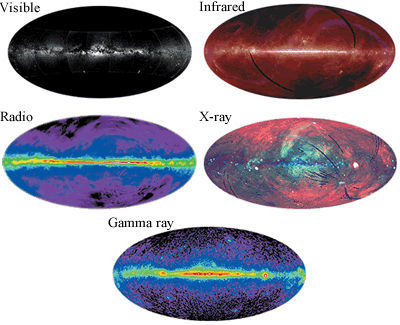
These images of our galaxy, the Milky Way, were taken in five wavelength ranges: visible, radio, infrared, X-rays and gamma rays. Each image is a full-sky image. (Think of it like a map of the Earth projected in two dimensions except that in this case, we are looking from inside of the sphere instead of from outside). The center of the Galaxy is located at the center of each image.
The black arcs in the infrared and X-ray images are swaths where the telescope didn't take any data. Black anywhere else means that no light in that particular wavelength was detected!
Question 6.11
xsS5X83ZNXx6CS0+2YcCbne7URsgxHkpaxq/zI4kg7Tm7xm3c5ywxyblfb52h8JMMdUeUM0STLyr3NDgqcYM2oMGqIaubdzbBG6vA6/+ckjlzwmw3Q9AL50QQ/BsBOUC+7+/Pr2u0ouH34AkOPScr3FyOZwYTczz3pohciUY1s36/gG4+0W0ZuD6IEKEXI6jp7Gv958sMMpqBSm5Gx5XkgmYbuCChJWnSummary
We cannot see the center of our galaxy due to the presence of dust that blocks visible light, but not other wavelengths. Certain objects in space glow more strongly at one wavelength rather than another, and many objects emit light at many wavelengths. This is why astronomers find it so important to study astronomy at all wavelengths. If we limited ourselves only to ground-based observations of light that can pass through Earth's atmosphere, we would be missing out on so much.
6.15 Quick Check Quiz
Indepth Activity: Telescopes in Space